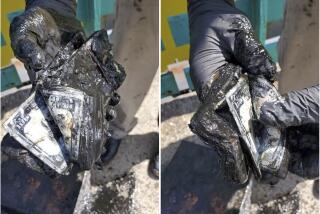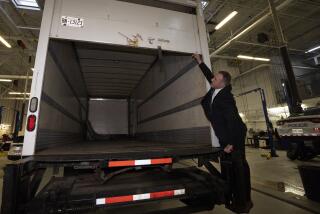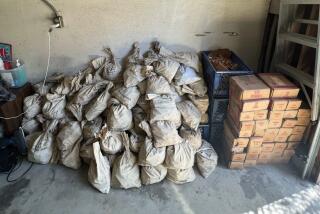OCTD Fares: Money That Talks--Loudly
- Share via
Thwunk! Whooooosh. Thousands of coins were slurped from the bus with a twist of the vacuum--50 pounds of change in less than 30 seconds.
“It’s pretty fast,” cautioned Sam Russo, fare box mechanic for the Orange County Transit District, as he demonstrated the vacuum probe. “It’ll suck your hand in.”
And at that rate the coins pile up pretty fast--about nine tons of pennies, nickels, dimes and quarters a week. Here in Garden Grove and at two other sites in Orange County, the counting journey begins when the bus district’s 440 buses pull up to disgorge the day’s fares.
In a dizzy tumble rivaling Alice’s fall into Wonderland, $12.5 million in coins annually pass through the county’s bus fare boxes.
After swimming through vacuum tubes, bins, chutes, sorters and conveyor belts, all that silver, nickel, tin and copper ends its journey from the bus riders’ pockets in a tiny counting room. Here, the ear-shattering din rings like hand grenades exploding in a tin closet as the coin sacks fill up.
“Sounds more like a machine gun,” said Margaret Thornton, the no-nonsense supervisor of coin counters, who somehow manages to keep her cool and humor through all the noise and clatter. The earplugs help.
Sucked from the bus fare box innards by mechanical vacuums, the coins are emptied through a long tube into a nearby bin. Dropped onto vibrating metal plates stacked in layers and drilled through with holes corresponding to the circumference of different coins, the separated change drops down a chute.
Below the chute, sealed vaults await their booty. Piles of Lincolns, Jeffersons, Washingtons and FDRs--some 500 tons of coinage a year, the weight equivalent of 28 buses--accumulate in separate vault chambers.
But about once a year someone forgets to open the vault chambers before turning on the vacuum. The separated coins then tumble down the chute and spill all over the place.
Which indeed happened last week, somewhat to the dismay of Thornton and her counters, just before a reporter and photographer came to observe the operation.
Although the counting work typically begins at 6 a.m., by 8 a.m. this day everyone was still busy scooping the errant coins.
George Colon, a bus district coin counter for three years, kneeled atop the bin making slow progress into huge piles of change with his plastic scoop--a gallon milk container with the top lopped off.
Counting money can be a dirty job, too. Colon held out a blackened palm for a hello handshake and apologized for the grime. “The coins really get dirty bumping against each other,” he said.
The process used to end at this point with a machine counting the separated change. A Brinks armored truck would pull up and haul the money away to the bank.
Change Disappeared
Things changed about seven years ago when some change disappeared between the vacuum probe and the bank.
“We didn’t have the money we should have,” Thornton said.
The authorities never figured out exactly how much change walked away, although a grand jury report released in 1984 said an OCTD internal audit estimated the loss at $40,000. Talk around the maintenance yard puts the number at $72,000 over a three-month period. “That’s about a bag a day,” one worker in blue sunglasses volunteered.
The Orange County district attorney’s office never prosecuted anyone in connection with the missing money. But OCTD hired Thornton to keep a closer eye on things.
Thornton came to buses from water.
She used to manage the coin counting at Sparkletts bottled water, checking the change from the firm’s vending machines set up outside supermarkets.
Ft. Knox it’s not, but the security she oversees today at the bus yards is tight.
It takes a key to stick the vacuum probe into the bus fare box. It takes two keys--one a supervisor’s--to open the vault room. Tampering with the locks sets off “a regular siren like, you know, fire engines,” Russo said. And a big red light flashes.
“It’s noticeable,” Thornton said, nodding her head.
To the final counting room where the forklifts trundle the vaults, two video cameras keep a steady gaze on the closet-sized room. The door opens with a key, and then an alarm must be disengaged using a special code within 30 seconds.
Technical innovation has introduced some comedy into the operation over the years.
It used to be that the coins had to be separated before they could be counted. The old machine didn’t like jumbled change. So after being vacuumed from the bus, the coins were sorted and then counted.
But the new counter, which resembles spinning wheels of metal Swiss cheese, works best with mixed change.
So now the change is counted and sorted twice. It didn’t make sense to get rid of the first sorter, since it did a fine job of dropping the vacuumed coins into the vaults anyway.
Today Thornton’s Brandt Model 966 copes quite well, thank you, sorting and counting the mixed change--about 70,000 coins an hour. The old counter gathers dust in the corner. And the new Jetsorter on its way will chew through the silver faster than any of them.
After the final count by an electric eye in the counter that keeps tabs of the coins, the coin bags are weighed on a scale--down to the hundredth of an ounce. A 49.52-pound sack of quarters, for example, holds exactly 4,000 stamped likenesses of George Washington.
At the end of the day, an armored truck hauls the bags up to a Federal Reserve Bank in Monterey Park. “Regular banks wouldn’t want all these coins,” Thornton said.
The guitar picks, peep show tokens, Chuck E. Cheese coins, pesos, Exacto blades--even the occasional diamond ring--are all residue from the sorting process and left behind for Thornton to ponder and place in the lost-and-found boxes.
“Anything someone puts in his pocket ends up in the fare boxes,” she said. “Pinto beans. Anything. You can find it.”
Some of those anythings can be quite inventive. Thornton pointed to a wooden wafer on her desk with photocopies of the head and tail side of a quarter pasted on it.
Others can be quite quirky and without explanation.
Picking up a quarter cut carefully into thirds by a jeweler’s saw along George Washington’s profile and held together by plastic tape, she smiled. “Can you imagine somebody went to all the trouble to do this? And why?”
More to Read
Sign up for Essential California
The most important California stories and recommendations in your inbox every morning.
You may occasionally receive promotional content from the Los Angeles Times.










